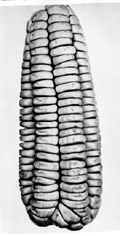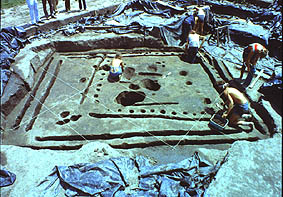
Modern eight-row corn.

Prehistoric maize cob.

Modern eight-row corn. |
Although early varieties of domesticated maize from Central American caves are at least 8000 years old, a later variety apparently adapted to northern climates and growing conditions did not reach eastern North America until about 2000 years ago (Riley et al. 1994). By about 1200 years ago, however, maize was having a dramatic impact on Native American subsistence economies in the Midwest. |

Prehistoric maize cob. |

Storage pits in a wall trench house, Merrell Tract, Cahokia Mounds Museum |
For the Late Woodland and Emergent Mississippian farmers of the American Bottom, the advantages of this new food source must have been obvious. This grass grew well during the hot and humid summers in the bottoms of the midwest. Barring floods or droughts, bountiful harvests could be counted on year after year from fields that once cleared, required relatively little maintenance. Although the protein and fat content of its seeds were not significantly greater than those of native grasses, caloric content of maize was enormous compared to the smaller-seeded, native cultigens (HDYK-ECON). The real benefit seems to be that, great quantities of maize could be easily grown and the surplus stored in underground pits, the pantries of the past. |
Finally, unlike most midwestern wild plants and cultigens, which ripened later in the summer and fall, green maize could be harvested and eaten in mid-summer.